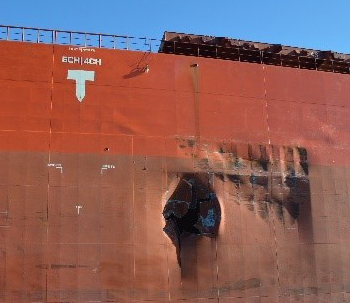(RICHMOND, British Columbia) — The Transportation Safety Board of Canada (TSB) has determined that poor communication and improper equipment preparation were key factors in the striking of the anchored bulk carrier Pan Acacia by the bulk carrier Caravos Harmony in Vancouver Harbor in 2019.
On March 17, 2019, Caravos Harmony, under the conduct of a pilot and with 22 people on board, struck Pan Acacia while proceeding to Anchorage D in the harbor. Both vessels sustained damage. No pollution or injuries were reported.
The investigation determined that as Caravos Harmony entered First Narrows, the strong current and eddies caused the vessel to sheer to port. The pilot gave full ahead and starboard helm orders in an attempt to correct the vessel’s course, but engine orders were ineffective and the vessel continued moving to port.
The pilot then ordered the starboard anchor to be released so that the vessel would swing to starboard. However, neither of the anchors had been prepared for deployment as requested by the pilot, and the starboard anchor was stuck in the stowed position and could not be released. With only the port anchor available and having a differing understanding of the situation from that of the pilot, the master ordered the port anchor to be dropped with the aim of bringing the vessel to a stop. This caused the vessel to move farther to port. Shortly thereafter, Caravos Harmony struck Pan Acacia.

The investigation also determined that communication breakdowns impacted the bridge team’s situational awareness and resulted in different understandings of the emerging circumstances. During the occurrence, the pilot and bridge crew did not share critical information to build a common and accurate understanding of the situation, and this impeded timely and effective coordination of actions to safely maneuver the vessel and avoid the accident.
Additionally, it was found that if familiarization of essential shipboard machinery and equipment is not effective, and if necessary instruction manuals and vessel-specific procedures and training are not provided, the crew may not be proficient in the use of the equipment, increasing the risk of accident or injury.
Following the occurrence, the ship manager took several actions, including a review of the performance of the crew and the crewing agents. The manager replaced the crewing agents at the time of the occurrence with a new fully certified agency and requested that senior officers be provided with additional training and familiarization before boarding.
The Pacific Pilotage Authority (PPA) and British Columbia Coast Pilots Ltd. conducted a risk assessment on loaded bulk carriers entering Vancouver Harbor on a strong flood tide and implemented additional measures to mitigate the risk of a similar occurrence. Moreover, the Vancouver Fraser Port Authority amended its rules for vessels refueling at English Bay. As of July 2020, refueling of all vessels can occur in English Bay, thereby reducing the number of inbound laden bulk carriers transiting through the First Narrows Traffic Control Zone (TCZ-1).
Click here to read the complete report.
– Transportation Safety Board of Canada
